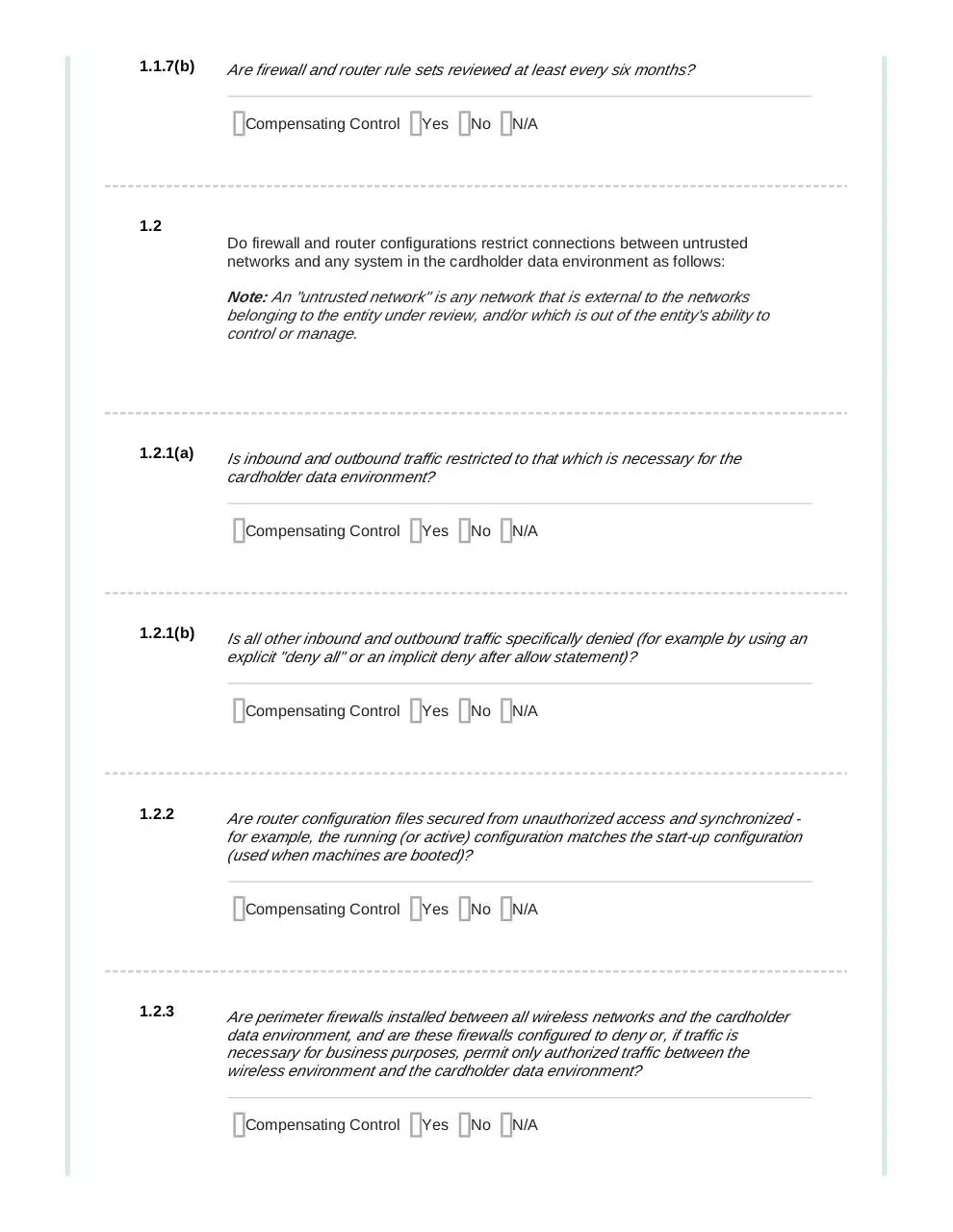pci dss saq (PDF)
File information
Title: SAQ Document
This PDF 1.4 document has been generated by / iText 2.1.7 by 1T3XT, and has been sent on pdf-archive.com on 02/05/2017 at 03:55, from IP address 70.44.x.x.
The current document download page has been viewed 718 times.
File size: 118.3 KB (40 pages).
Privacy: public file





File preview
Questionnaire SAQ A-EP
Build and Maintain a Secure Network and Systems : 45 questions to be completed
Protect Cardholder Data : 7 questions to be completed
Maintain a Vulnerability Management Program : 30 questions to be completed
Implement Strong Access Control Measures : 35 questions to be completed
Regularly Monitor and Test Networks : 48 questions to be completed
Maintain an Information Security Policy : 18 questions to be completed
Build and Maintain a Secure Network and Systems
Install and maintain a firewall configuration to protect cardholder data
1.1
Are firewall and router configuration standards established and implemented to
include the following:
1.1.1
Is there a formal process for approving and testing all network connections and
changes to the firewall and router configurations?
Compensating Control X Yes
1.1.2(a)
Yes
No
N/A
Is there a process to ensure the diagram is kept current?
Compensating Control
1.1.3(a)
N/A
Is there a current network diagram that documents all connections between the
cardholder data environment and other networks, including any wireless networks?
Compensating Control
1.1.2(b)
No
Yes
No
N/A
Is there a current diagram that shows all cardholder data flows across systems and
networks?
Compensating Control
Yes
No
N/A
1.1.3(b)
Is there a process to ensure the diagram is kept current?
Compensating Control
1.1.4(a)
No
N/A
Yes
No
N/A
Yes
No
N/A
Are all insecure services, protocols, and ports identified, and are security features
documented and implemented for each identified service?
Compensating Control
1.1.7(a)
Yes
Do firewall and router configuration standards include a documented list of services,
protocols, and ports, including business justification and approval for each?
Compensating Control
1.1.6(b)
N/A
Is the current network diagram consistent with the firewall configuration standards?
Compensating Control
1.1.6(a)
No
Is a firewall required and implemented at each Internet connection and between any
demilitarized zone (DMZ) and the internal network zone?
Compensating Control
1.1.4(b)
Yes
Yes
No
N/A
Do firewall and router configuration standards require review of firewall and router
rule sets at least every six months?
Compensating Control
Yes
No
N/A
1.1.7(b)
Are firewall and router rule sets reviewed at least every six months?
Compensating Control
Yes
No
N/A
1.2
Do firewall and router configurations restrict connections between untrusted
networks and any system in the cardholder data environment as follows:
Note: An "untrusted network" is any network that is external to the networks
belonging to the entity under review, and/or which is out of the entity's ability to
control or manage.
1.2.1(a)
Is inbound and outbound traffic restricted to that which is necessary for the
cardholder data environment?
Compensating Control
1.2.1(b)
N/A
Yes
No
N/A
Are router configuration files secured from unauthorized access and synchronized for example, the running (or active) configuration matches the start-up configuration
(used when machines are booted)?
Compensating Control
1.2.3
No
Is all other inbound and outbound traffic specifically denied (for example by using an
explicit "deny all" or an implicit deny after allow statement)?
Compensating Control
1.2.2
Yes
Yes
No
N/A
Are perimeter firewalls installed between all wireless networks and the cardholder
data environment, and are these firewalls configured to deny or, if traffic is
necessary for business purposes, permit only authorized traffic between the
wireless environment and the cardholder data environment?
Compensating Control
Yes
No
N/A
1.3
Is direct public access prohibited between the Internet and any system component
in the cardholder data environment, as follows:
1.3.1
Is a DMZ implemented to limit inbound traffic to only system components that
provide authorized publicly accessible services, protocols, and ports?
Compensating Control
1.3.2
No
N/A
Is inbound Internet traffic limited to IP addresses within the DMZ?
Compensating Control
1.3.3
Yes
Yes
No
N/A
Are anti-spoofing measures implemented to detect and block forged sourced IP
addresses from entering the network?
(For example, block traffic originating from the internet with an internal address.)
Compensating Control
1.3.4
N/A
Yes
No
N/A
Are only established connections permitted into the network?
Compensating Control
1.3.7(a)
No
Is outbound traffic from the cardholder data environment to the Internet explicitly
authorized?
Compensating Control
1.3.5
Yes
Yes
No
N/A
Are methods in place to prevent the disclosure of private IP addresses and routing
information to the Internet?
Note: Methods to obscure IP addressing may include, but are not limited to:
Network Address Translation (NAT)
Placing servers containing cardholder data behind proxy servers/firewalls,
Removal or filtering of route advertisements for private networks that employ
registered addressing,
Internal use of RFC1918 address space instead of registered addresses.
Compensating Control
1.3.7(b)
Yes
No
N/A
Yes
No
N/A
Is the personal firewall software (or equivalent functionality) configured to specific
configuration settings, actively running, and not alterable by users of mobile and/or
employee-owned devices?
Compensating Control
1.5
N/A
Is personal firewall software (or equivalent functionality) installed and active on any
portable computing devices (including company and/or employee-owned) that
connect to the Internet when outside the network (for example, laptops used by
employees), and which are also used to access the CDE?
Compensating Control
1.4(b)
No
Is any disclosure of private IP addresses and routing information to external entities
authorized?
Compensating Control
1.4(a)
Yes
Yes
No
N/A
Are security policies and operational procedures for managing firewalls:
Documented
In use
Known to all affected parties?
Compensating Control
Yes
No
N/A
Do not use vendor-supplied defaults for system passwords and other
security parameters
2.1(a)
Are vendor-supplied defaults always changed before installing a system on the
network?
This applies to ALL default passwords, including but not limited to those used by
operating systems, software that provides security services, application and system
accounts, point-of-sale (POS) terminals, payment applications, Simple Network
Management Protocol (SNMP) community strings, etc.
Compensating Control
2.1(b)
No
N/A
Are unnecessary default accounts removed or disabled before installing a system
on the network?
Compensating Control
2.2(a)
Yes
Yes
No
N/A
Are configuration standards developed for all system components and are they
consistent with industry-accepted system hardening standards?
Sources of industry-accepted system hardening standards may include, but are not
limited to, SysAdmin Audit Network Security (SANS) Institute, National Institute of
Standards Technology (NIST), International Organization for Standardization (ISO),
and Center for Internet Security (CIS).
Compensating Control
2.2(b)
No
N/A
Are system configuration standards updated as new vulnerability issues are
identified, as defined in Requirement 6.1?
Compensating Control
2.2(c)
Yes
Yes
No
N/A
Are system configuration standards applied when new systems are configured?
Compensating Control
2.2(d)
Yes
No
N/A
Do system configuration standards include all of the following:
Changing of all vendor-supplied defaults and elimination of unnecessary
default accounts?
Implementing only one primary function per server to prevent functions that
require different security levels from co-existing on the same server?
Enabling only necessary services, protocols, daemons, etc., as required for
the function of the system?
Implementing additional security features for any required services, protocols
or daemons that are considered to be insecure?
Configuring system security parameters to prevent misuse?
Removing all unnecessary functionality, such as scripts, drivers, features,
subsystems, file systems, and unnecessary web servers?
Compensating Control
2.2.1(a)
Yes
No
N/A
Is only one primary function implemented per server, to prevent functions that
require different security levels from co-existing on the same server?
For example, web servers, database servers, and DNS should be implemented on
separate servers.
Compensating Control
2.2.1(b)
No
N/A
If virtualization technologies are used, is only one primary function implemented per
virtual system component or device?
Compensating Control
2.2.2(a)
Yes
Yes
No
N/A
Are only necessary services, protocols, daemons, etc. enabled as required for the
function of the system (services and protocols not directly needed to perform the
device's specified function are disabled)?
Compensating Control
Yes
No
N/A
2.2.2(b)
Are all enabled insecure services, daemons, or protocols justified per documented
configuration standards?
Compensating Control
2.2.3
Yes
No
N/A
Are additional security features documented and implemented for any required
services, protocols or daemons that are considered to be insecure?
Note:Where SSL/early TLS is used, the requirements in Appendix A2 must be
completed.
Compensating Control
2.2.4(a)
Yes
No
N/A
Yes
No
N/A
Are security parameter settings set appropriately on system components?
Compensating Control
2.2.5(a)
N/A
Are common system security parameters settings included in the system
configuration standards?
Compensating Control
2.2.4(c)
No
Are system administrators and/or personnel that configure system components
knowledgeable about common security parameter settings for those system
components?
Compensating Control
2.2.4(b)
Yes
Yes
No
N/A
Has all unnecessary functionality such as scripts, drivers, features, subsystems, file
systems, and unnecessary web servers been removed?
Compensating Control
Yes
No
N/A
2.2.5(b)
Are enabled functions documented and do they support secure configuration?
Compensating Control
2.2.5(c)
Yes
No
N/A
Is only documented functionality present on system components?
Compensating Control
Yes
No
N/A
2.3
Is non-console administrative access encrypted as follows:
Note: Where SSL/early TLS is used, the requirements in Appendix A2 must be
completed.
2.3(a)
Is all non-console administrative access encrypted with strong cryptography, and is
a strong encryption method invoked before the administrator's password is
requested?
Compensating Control
2.3(b)
No
N/A
Are system services and parameter files configured to prevent the use of Telnet and
other insecure remote login commands?
Compensating Control
2.3(c)
Yes
Yes
No
N/A
Is administrator access to web-based management interfaces encrypted with strong
cryptography?
Compensating Control
Yes
No
N/A
Download pci dss saq
pci_dss_saq.pdf (PDF, 118.3 KB)
Download PDF
Share this file on social networks
Link to this page
Permanent link
Use the permanent link to the download page to share your document on Facebook, Twitter, LinkedIn, or directly with a contact by e-Mail, Messenger, Whatsapp, Line..
Short link
Use the short link to share your document on Twitter or by text message (SMS)
HTML Code
Copy the following HTML code to share your document on a Website or Blog
QR Code to this page

This file has been shared publicly by a user of PDF Archive.
Document ID: 0000591338.